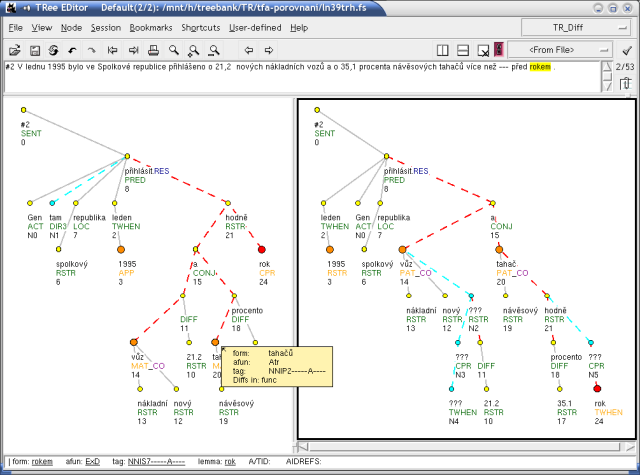TrEd is a fully customizable and programmable graphical editor and viewer of tree-like structures such as dependency trees. Among other projects, it was used as the main annotation tool for syntactical and tectogrammatical annotations of The Prague Dependency Treebank, as well as for decision-tree based morphological annotation of The Prague Arabic Dependency Treebank.
TrEd provides various ways to customize the tree layout and appearance. It's functionality may be further extended by user-defined macros (small program subroutines written in Perl) associated with keyboard shortcuts and/or menu items. TrEd also provides wide range of pre-defined macros, which greatly simplifies writing new macros. By writing a suitable set of macros, TrEd may be easily turned from a general-purpose software into a specialized tool for a particular purpose.
TrEd supports various input and output formats. Some of them are of general nature (one of them is FS-format developed by Michal Kren and sufficient enough for most purposes), while other are bound to a particular project. Support for other formats can be added by writing a custom I/O Backend (a Perl module able to convert data from their format-specific representation into the internal representation used by TrEd, and save them back in the original format).
There is also a non-graphical (off-line) variant of TrEd, usefull for batch processing of tree-like data. It is called btred — “Batch-mode Tree Editor” and allows users to apply TrEd macros on trees without having to enter the graphical interface. This tool is further acompanied by another tool, named ntred. NTrEd allows for parallelizing btred processing over a cluster of networked machines. In combination with TrEd, it can also be used as an extremely powerful search engine over large base of data.
Figure 1. TrEd's main window with two views highly customized for visual comparison of trees of the Prague Dependency Treebank project.

TrEd runs on the following platforms (see Section 2, “Installation and start up instructions” for details):
Windows 95/98/ME™ or Windows NT/2000/XP™
Linux™
MacOS X™ (X11), BSD™, UNIX™, Solaris™ and other UNIX-based systems